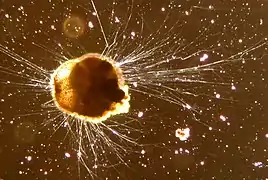Ammonia tepida
Ammonia tepida is a benthic foraminifer living in the sediment of brackish waters. It is very similar to Ammonia beccarii, but the latter lives on the surface of red algae.[2] Once considered a globally widespread taxon, a recent genetic and morphological study has revealed that many of what were once considered members of A. tepida in fact represent other species of Ammonia, primarily Ammonia veneta, with true specimens of A. tepida only being found in Atlantic waters, off the coast of the Americas.[3]
| Ammonia tepida Temporal range: M Cretaceous - recent | |
|---|---|
 | |
| Live Ammonia veneta, the globally distributed species formerly misidentified as A. tepida. | |
| Scientific classification | |
| Domain: | Eukaryota |
| (unranked): | SAR |
| (unranked): | |
| Superphylum: | |
| Phylum: | |
| Order: | |
| Superfamily: | Rotalioidea |
| Family: | Rotaliidae |
| Genus: | |
| Species: | A. tepida |
| Binomial name | |
| Ammonia tepida Cushman, 1926 | |
| Synonyms[1] | |
|
Ammonia beccarii var. tepida Cushman, 1926 | |
Ecology
Ammonia tepida is found in the sediment of brackish waters. It is able to tolerate a wide range of temperatures and degrees of salinity, as well as to survive severe environmental conditions. As it is easy to keep in the laboratory, being able to reproduce both asexually and sexually without problem, it considered an ideal organism for laboratory studies.[4]
The diet of A. tepida consists mainly of other microorganisms. Algae form about 80–90% of its diet and the remaining is composed by bacteria.[5] Laboratory experiments showed that it may also prey on small animals, such as nematodes, copepods and mollusk larvae.[6]
References
- "WoRMS - World Register of Marine Species - Ammonia tepida (Cushman, 1926)".
- Debenay, Jean-Pierre; Bénéteau, Eric; Zhang, Jijun; Stouff, Véronique; Geslin, Emmanuelle; Redois, Fabrice; Fernandez-Gonzalez, Marialsira (1998). "Ammonia beccarii and Ammonia tepida (Foraminifera): morphofunctional arguments for their distinction". Marine Micropaleontology. 34 (3–4): 235–244. doi:10.1016/S0377-8398(98)00010-3. ISSN 0377-8398.
- Hayward, B.W.; Holzmann, M; Pawlowski, J; Parker, J.H.; Kaushik, T; Toyofuku, M.S.; Tsuchiya, M (2021). "'Molecular and morphological taxonomy of living Ammonia and related taxa (Foraminifera) and their biogeography". Micropaleontology. 67 (2–3): 109–313. doi:10.47894/mpal.67.2-3.01. ISSN 0377-8398.
- Munsel, D.; Kramar, U.; Dissard, D.; Nehrke, G.; Berner, Z.; Bijma, J.; Reichart, G.-J.; Neumann, T. (2010). "Heavy metal incorporation in foraminiferal calcite: results from multi-element enrichment culture experiments with Ammonia tepida". Biogeosciences. 7 (8): 2339–2350. doi:10.5194/bg-7-2339-2010. ISSN 1726-4189.

- Pascal, Pierre-Yves; Dupuy, Christine; Richard, Pierre; Niquil, Nathalie (2008). "Bacterivory in the common foraminifer Ammonia tepida: Isotope tracer experiment and the controlling factors". Journal of Experimental Marine Biology and Ecology. 359 (1): 55–61. doi:10.1016/j.jembe.2008.02.018. ISSN 0022-0981.
- Dupuy, C.; Rossignol, L.; Geslin, E.; Pascal, P.-Y. (2010). "Predation of mudflat meio-macrofaunal metazoans by a calcareous foraminifer, Ammonia tepida (Cushman, 1926)" (PDF). The Journal of Foraminiferal Research. 40 (4): 305–312. doi:10.2113/gsjfr.40.4.305. ISSN 1937-2795.
Further reading
Ruiz, Francisco; Gonzalez-Regalado, Maria Luz; Abad, Manuel; Munoz, Juan Manuel; Pino, Rafael (October 2007). "New applications of the Poisson distribution in micropalaeontology: relationships between environmental variables and the Ammonia tepida distribution in the south-western Spanish estuaries". Terra Nova. 19 (5): 372. doi:10.1111/j.1365-3121.2007.00761.x.